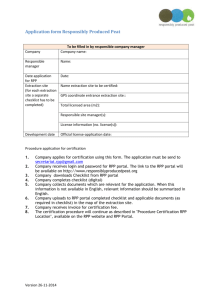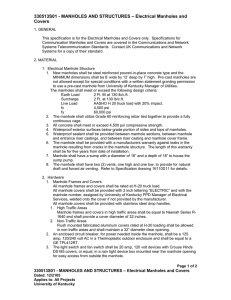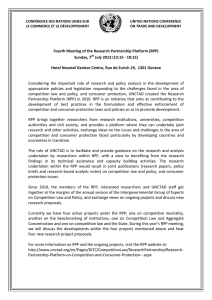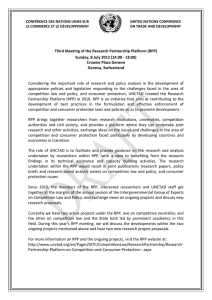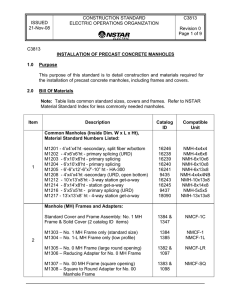Predicting Power Failures with Reactive Point Processes S¸eyda Ertekin Cynthia Rudin
advertisement
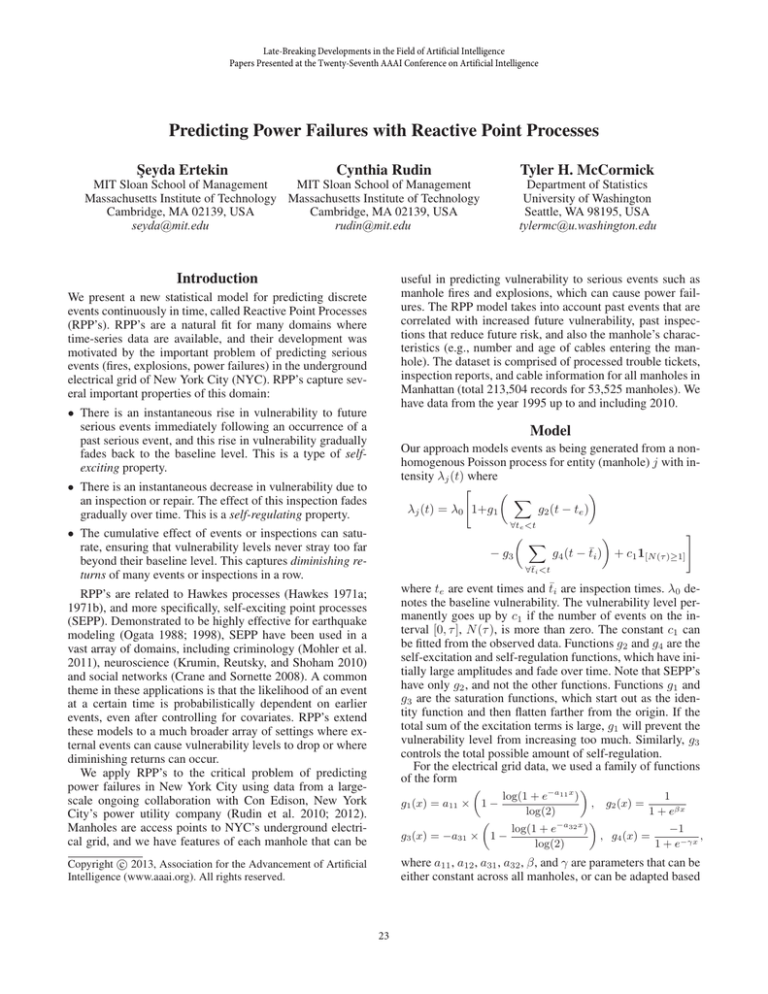
Late-Breaking Developments in the Field of Artificial Intelligence Papers Presented at the Twenty-Seventh AAAI Conference on Artificial Intelligence Predicting Power Failures with Reactive Point Processes Şeyda Ertekin Tyler H. McCormick Cynthia Rudin Department of Statistics University of Washington Seattle, WA 98195, USA tylermc@u.washington.edu MIT Sloan School of Management MIT Sloan School of Management Massachusetts Institute of Technology Massachusetts Institute of Technology Cambridge, MA 02139, USA Cambridge, MA 02139, USA rudin@mit.edu seyda@mit.edu Introduction useful in predicting vulnerability to serious events such as manhole fires and explosions, which can cause power failures. The RPP model takes into account past events that are correlated with increased future vulnerability, past inspections that reduce future risk, and also the manhole’s characteristics (e.g., number and age of cables entering the manhole). The dataset is comprised of processed trouble tickets, inspection reports, and cable information for all manholes in Manhattan (total 213,504 records for 53,525 manholes). We have data from the year 1995 up to and including 2010. We present a new statistical model for predicting discrete events continuously in time, called Reactive Point Processes (RPP’s). RPP’s are a natural fit for many domains where time-series data are available, and their development was motivated by the important problem of predicting serious events (fires, explosions, power failures) in the underground electrical grid of New York City (NYC). RPP’s capture several important properties of this domain: • There is an instantaneous rise in vulnerability to future serious events immediately following an occurrence of a past serious event, and this rise in vulnerability gradually fades back to the baseline level. This is a type of selfexciting property. Model Our approach models events as being generated from a nonhomogenous Poisson process for entity (manhole) j with intensity λj (t) where " X λj (t) = λ0 1+g1 g2 (t − te ) • There is an instantaneous decrease in vulnerability due to an inspection or repair. The effect of this inspection fades gradually over time. This is a self-regulating property. ∀te <t • The cumulative effect of events or inspections can saturate, ensuring that vulnerability levels never stray too far beyond their baseline level. This captures diminishing returns of many events or inspections in a row. − g3 X # g4 (t − t̄i ) + c1 1[N (τ )≥1] ∀t̄i <t where te are event times and t̄i are inspection times. λ0 denotes the baseline vulnerability. The vulnerability level permanently goes up by c1 if the number of events on the interval [0, τ ], N (τ ), is more than zero. The constant c1 can be fitted from the observed data. Functions g2 and g4 are the self-excitation and self-regulation functions, which have initially large amplitudes and fade over time. Note that SEPP’s have only g2 , and not the other functions. Functions g1 and g3 are the saturation functions, which start out as the identity function and then flatten farther from the origin. If the total sum of the excitation terms is large, g1 will prevent the vulnerability level from increasing too much. Similarly, g3 controls the total possible amount of self-regulation. For the electrical grid data, we used a family of functions of the form RPP’s are related to Hawkes processes (Hawkes 1971a; 1971b), and more specifically, self-exciting point processes (SEPP). Demonstrated to be highly effective for earthquake modeling (Ogata 1988; 1998), SEPP have been used in a vast array of domains, including criminology (Mohler et al. 2011), neuroscience (Krumin, Reutsky, and Shoham 2010) and social networks (Crane and Sornette 2008). A common theme in these applications is that the likelihood of an event at a certain time is probabilistically dependent on earlier events, even after controlling for covariates. RPP’s extend these models to a much broader array of settings where external events can cause vulnerability levels to drop or where diminishing returns can occur. We apply RPP’s to the critical problem of predicting power failures in New York City using data from a largescale ongoing collaboration with Con Edison, New York City’s power utility company (Rudin et al. 2010; 2012). Manholes are access points to NYC’s underground electrical grid, and we have features of each manhole that can be log(1 + e−a11 x ) 1 g1 (x) = a11 × 1 − , g2 (x) = log(2) 1 + eβx log(1 + e−a32 x ) −1 g3 (x) = −a31 × 1 − , g4 (x) = , log(2) 1 + e−γx where a11 , a12 , a31 , a32 , β, and γ are parameters that can be either constant across all manholes, or can be adapted based c 2013, Association for the Advancement of Artificial Copyright Intelligence (www.aaai.org). All rights reserved. 23 g2 values from case control fitted g2 15 g1 values from case control fitted g1 20 10 4 2 5 0 0 −10 −10 0 −2 0 10 10 Age 6 Age 8 200 400 Number of Days (a) Fitted g2 600 0 0.52 1.57 2.61 Bin Ranges 3.66 4.70 (b) Fitted g1 10 0 Main PH −10 −20 0 −10 10 Total Num Sets (c) KL Divergence 10 0 −10 −10 10 0 Main PH −20 20 Total Num. Sets (d) Log-Likelihood Figure 1: Results for the Manhattan Dataset. Figures 1(a) and 1(b) show the fitted functions for the Manhattan dataset from Case Control. Figures 1(c) and 1(d) show the KL Divergence from ABC and the Log-Likelihood, respectively. on the manhole’s features. For instance, our experimental analysis covers both constant β across all manholes as well as an adaptive β, modeled for manhole k as: Pn βk = log 1 + e− i=1 θi fik We use KL Divergence to measure differences in the distribution of time between events for the observed data and the distribution of time between events generated using our candidate parameter values. In Figure 1(c) the blue boundary corresponds to the region that yields the minimum divergence, and the optimum parameter values can be derived by fitting a manifold on that region. We also experimented with model fitting using Maximum Likelihood techniques. Figure 1(d) demonstrates the region of maximum likelihood (shown in dark red), where the simulated vulnerabilities are in closest proximity of actual vulnerabilities. where θi is the coefficient of feature i and fik is the value of feature i for manhole k. For our dataset, the features include the number of main phase cables, age of the oldest cable, and the total number of cable sets inside the manhole. Model Fitting and Experiments We will introduce several methods for fitting RPP’s below. To verify that the methods are working properly, we used simulated data where ground truth was available (not shown here) to demonstrate that the underlying function could be recovered. Prediction Performance Evaluation We assessed the predictive performance of our RPP model by comparing it against Cox Proportional Hazards Model (Cox 1972), which is a commonly used technique in survival analysis. We trained both an RPP model and a Cox model (available in the survival package in R) on the historical event records up to the year 2010 and used the models to predict vulnerabilities of each manhole on each day of 2010. We then generated a ranked list of manholes for each day with the most vulnerable manhole ranked at the top. For each manhole that had an event during a day, we compared the rank of that manhole in the two ranked lists. Aggregated over days in 2010 where an event was recorded, the RPP model ranked the manholes with events significantly higher than the Cox model in its lists, indicating that the RPP model more accurately measures short term vulnerabilities. Case Control The Case Control method allows us to nonparametrically trace out the shapes of g1 , g2 , g3 , and g4 , using only relevant manholes to estimate specific points of each function. Figures 1(a) and 1(b) show g2 and g1 from Manhattan manholes, traced out (in blue) using the Case Control method, and parameterized (in P red) afterwards. For the g1 curve, the range of observed g2 values in the data was discretized into equal sized bins, and the likelihood of an event if the sum value falls within the range of a bin was used to fit g1 . Bayesian and Maximum Likelihood Approaches The Case Control method is useful for finding parameterizations of the functions, but there are not enough data to permit its use when we would like to customize g1 , g2 , g3 , and g4 to each individual manhole. Based on insights gleaned from the Case Control method we explore both Bayesian and Maximum Likelihood approaches to model fitting. For our Bayesian approach, we use the model for the βk ’s with covariates described above, where each coefficient has a Gaussian prior distribution. We fit the model using Approximate Bayesian Computation (ABC). To do this, we evaluated the suitability of simulated data generated using a given candidate parameter via two statistics, one consisting of the number of events and another related to the distribution of time between events. Since RPP’s model association between event times, the second statistic is important. Understanding the Impact of Inspection Policies Beyond identifying the vulnerable manholes to be targeted for repair and inspection, we used the RPP model to simulate the effect of different broad inspection policies. Our simulations show that there is a natural inverse relationship between the number of events and the number of inspections: more inspections lead to fewer events. Using our simulations, we can quantify an optimal trade off between the anticipated number of events and the cost of inspections. This can assist Con Edison to make decisions between candidate inspection policies. 24 References Cox, D. R. 1972. Regression models and life-tables. Journal of the Royal Statistical Society. Series B (Methodological) 187–220. Crane, R., and Sornette, D. 2008. Robust dynamic classes revealed by measuring the response function of a social system. Proceedings of the National Academy of Sciences 105(41):15649–15653. Mohler, G.; Short, M.; Brantingham, P.; Schoenberg, F.; and Tita, G. 2011. Self-exciting point process modeling of crime. Journal of the American Statistical Association 106(493):100–108. Krumin, M.; Reutsky, I.; and Shoham, S. 2010. Correlationbased analysis and generation of multiple spike trains using Hawkes models with an exogenous input. Frontiers in computational neuroscience 4. Ogata, Y. 1988. Statistical Models for Earthquake Occurrences and Residual Analysis for Point Processes. Journal of the American Statistical Association 83(401):9–27. Ogata, Y. 1998. Space-time point-process models for earthquake occurrences. Annals of the Institute of Statistical Mathematics 50(2):379–402. Rudin, C.; Passonneau, R.; Radeva, A.; Dutta, H.; Ierome, S.; and Isaac, D. 2010. A process for predicting manhole events in Manhattan. Machine Learning 80:1–31. Rudin, C.; Waltz, D.; Anderson, R. N.; Boulanger, A.; Salleb-Aouissi, A.; Chow, M.; Dutta, H.; Gross, P.; Huang, B.; Ierome, S.; Isaac, D.; Kressner, A.; Passonneau, R. J.; Radeva, A.; and Wu, L. 2012. Machine learning for the New York City power grid. IEEE Transactions on Pattern Analysis and Machine Intelligence 34(2):328–345. Hawkes, A. 1971. Spectra of some self-exciting and mutually exciting point processes. Biometrika 58(1):83–90. Hawkes, A. 1971. Point Spectra of Some Mutually Exciting Point Processes. Journal of the Royal Statistical Society 33(3):438–443. 25
